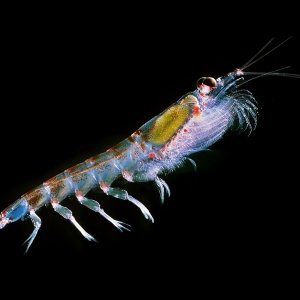
This review paper examines how people are increasingly using the ocean - even previously inaccessible areas - for seafood, animal feed, nutraceuticals (such as omega-3 fatty acids), fuels and minerals, shipping, waste disposal and many other purposes. It argues that the view of the ocean as being too big to be affected by humans is now outdated, and that effective governance is required to manage the ocean’s ecological health while allowing sustainable use of its resources.
The paper consider three major uses of the oceans:
- Food: Seafood has been the fastest-growing food industry since the 1960s, according to the paper, with wild-capture volumes levelling off since the 1990s but aquaculture continuing to expand. Fishmeal is often used as animal feed, both for aquaculture and for land-based livestock.
- Materials: Oil and gas account for one third of the economic value of ocean-based activity. Undersea mining of sand and gravel has become important because of demand from the construction industry, while mineral mining has been linked to demand for metals in high-tech products.
- Space: The ocean is used for purposes that do not require extraction of food or materials, such as transport, tourism, renewable energy, and conservation of marine ecosystems.
The paper argues that the rapid expansion (see figure below) of the use of ocean resources over the past few decades can be seen as a “Blue Acceleration”. These many growing uses can affect each other, e.g. offshore oil drilling causing fish stocks to move, undersea cables getting in the way of trawling, or fish catches increasing next to protected areas of the ocean.
 Image: Figure 2, Jouffray et al. Global trends in (A) marine aquaculture production; (B) deep offshore hydrocarbon production, including gas, crude oil, and natural gas liquids below 125 m; (C) total area of seabed under mining contract in areas beyond national jurisdiction; (D) cumulative contracted seawater desalination capacity; (E) accumulated number of marine genetic sequences associated with a patent with international protection; (F) accumulated number of casts added to the World Ocean Database; (G) container port traffic measured in Twenty-Foot Equivalent Units (TEU); (H) total length of submarine fiber optic cables; (I) number of cruise passengers; (J) cumulative offshore wind energy capacity installed; (K) total marine area protected; (L) total area of claimed extended continental shelf.
Image: Figure 2, Jouffray et al. Global trends in (A) marine aquaculture production; (B) deep offshore hydrocarbon production, including gas, crude oil, and natural gas liquids below 125 m; (C) total area of seabed under mining contract in areas beyond national jurisdiction; (D) cumulative contracted seawater desalination capacity; (E) accumulated number of marine genetic sequences associated with a patent with international protection; (F) accumulated number of casts added to the World Ocean Database; (G) container port traffic measured in Twenty-Foot Equivalent Units (TEU); (H) total length of submarine fiber optic cables; (I) number of cruise passengers; (J) cumulative offshore wind energy capacity installed; (K) total marine area protected; (L) total area of claimed extended continental shelf.
The paper sets out three case studies to illustrate the challenges of the “Blue Acceleration”:
- Local optimisation: Individual countries or industries may set growth targets that collectively become unsustainable. For example, near Norway, the salmon aquaculture, cruise tourism, oil and gas, and offshore wind farm industries all plan to expand significantly, despite existing tensions caused these industries (e.g. fishers are concerned about sea lice outbreaks originating from salmon farms).
- New frontiers: The scaly-foot snail, of interest to the US military because of its unique three-layered shell, is only found in three deep-sea hydrothermal vents. Two of these vent systems now fall within exploratory mining leases, putting the snail’s future at risk. The paper notes that all the metals found at the vents can be mined elsewhere, but demand for their use in electronics has contributed to a several-fold increase in their value over the last two decades, making deep-sea mining commercially viable.
- Global consequences: The South China Sea is an important region for fishing, undersea telecommunications cables and shipping, and is also an area where the territorial claims of several countries are disputed. If armed conflict were to occur (or appear likely to occur), the increased cost of insurance (e.g. for ships carrying goods) could affect the global economy.
The paper suggests that predicting the future of the ocean, its ecosystems and its use to humans is difficult, because of the interlinked and non-linear nature of the system. It also notes that the coming transformations in how the ocean is used are likely to benefit “economically powerful states and corporations”, while poorer nations, particularly small islands, may be harmed.
Abstract
Does humanity's future lie in the ocean? As demand for resources continues to grow and land-based sources decline, expectations for the ocean as an engine of human development are increasing. Claiming marine resources and space is not new to humanity, but the extent, intensity, and diversity of today's aspirations are unprecedented. We describe this as the blue acceleration - a race among diverse and often competing interests for ocean food, material, and space. Exploring what this new reality means for the global ocean and how to steer it in a sustainable and equitable way represents an urgent challenge.
Reference
Jouffray, J.B., Blasiak, R., Norström, A.V., Österblom, H. and Nyström, M., 2020. The Blue Acceleration: The Trajectory of Human Expansion into the Ocean. One Earth, 2(1), pp.43-54.
Read the full paper here. See also the Foodsource resource How do food systems affect fish stocks and marine habitats?







Post a new comment »